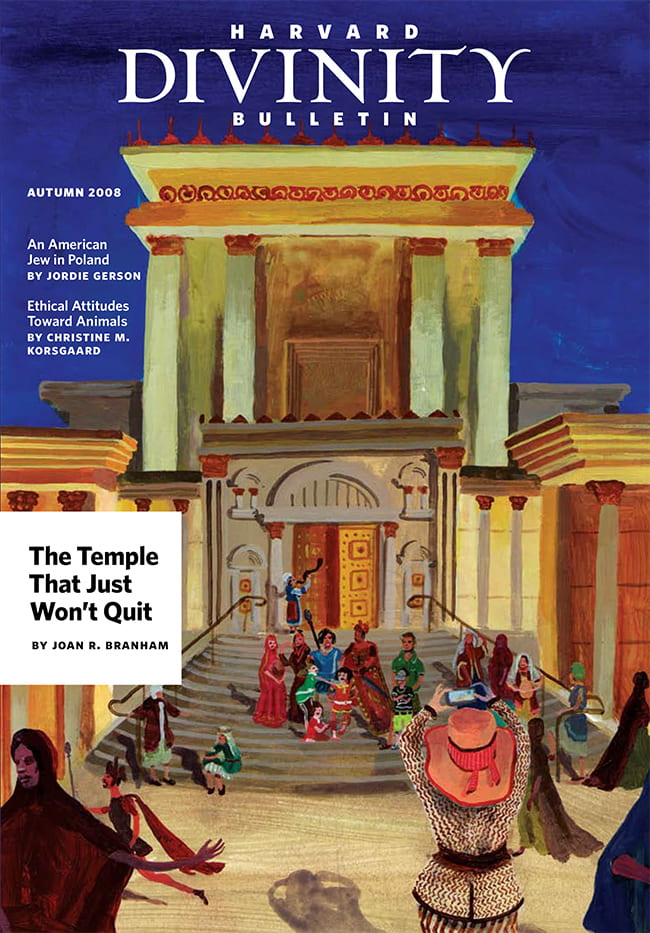
Perspective
Taking Stock
Cover illustration by Demetrios Psillos. Cover design by Point Five Design.
By Will Joyner
Summer can be a disconcerting time to be working on completion of a new issue of Harvard Divinity Bulletin. The campus is free of bustle, so our own bustle has an odd, disembodied quality to it. Most of our writers are attuned to the rhythms of academia, of course, and this means that in the summer months they are often off at far-flung foreign research sites, or in well-deserved pastoral hiding places, or in exhausting transit between the two. Final consultations on small editorial points can be a confusion of time zones and terse email messages.
Seen from another angle, however, assessing a new issue in the relative institutional quiet of August can be especially instructive. Without the daily flux of professors and students around us, the content of the magazine tends to stand out in special relief—to live or die on its own—as an embodiment of our mission. It becomes easier, or more likely, for us to step back and judge anew whether we who shepherd the Bulletin are living up to the challenges we set for ourselves in spring 2005, when the first issue of this incarnation of the publication appeared.
Those challenges were, and are, ambitious ones. As I wrote in spring 2005, in the first Perspective column, explaining the risks of such an undertaking: “Especially at a moment when conflict in public arenas so often involves religion, we believe it is important to open out the way we interpret, and reflect, Harvard Divinity School’s mission—which is preparing future scholars, ministers, and leaders across the professions according to a common intellectual rigor and with an emphasis on religious pluralism. We believe that this publication can be, in that regard, a broadly accessible—and broadly participated in—forum on questions of worldwide, ecumenical concern, with the School as its dynamic bedrock and monitor of excellence.”
From that initial charge, I went on to explain more specifically that we sought to include in the Bulletin’s pages a wide range of writers—writers who were religion scholars as well as writers who were more accustomed to approaching religion issues as journalists or creative writers; writers who were varied in their relationships to HDS and Harvard; writers linked to numerous faith traditions. Above all, I pointed out that we wanted to showcase lively, thoughtful, pointed writing from across the political, or ideological, spectrum. “The goal,” I wrote, “is not to temper opinions down to agreement. The goal is to nurture a place where responsible people can trade ideas, perhaps disagreeing strongly, so that the culture wars can more easily become meaningful cultural negotiations.”
Three and a half years later, judging according to these previously stated aspirations, I believe that this Autumn 2008 issue measures up very well as evidence of the Bulletin’s health and steady purpose. The rich array of writers here, for instance, includes: HDS and other Harvard faculty members, as well as scholars from other institutions; writers from several faiths; HDS alumni who also serve in ministry; a critic with no tie to Harvard who has become one of our natural “regulars”; and two noted American poets. In regard to content, Joan Branham’s cover article on the ways that ideas, images, and reconstructions of the “Jerusalem Temple” have been used, and misused, over the ages—up to today, at a theme park in Florida—is an ideal example of how a scholarly investigation can bear on contemporary cultural questions of interest to a broad general audience. So, too, is Christine Korsgaard’s meditation on our ethical stance, as humans, toward animals.
The three Dialogue articles on the state of “human rights” are both an exhibit of political “unpredictability” and another representation of the Bulletin’s commitment to reflect timely intellectual interchange at Harvard, in this case at a recent conference sponsored by the Nieman Foundation for Journalism with HDS. And Jordie Gerson’s searing narrative about her experience as an American Jew of Polish heritage who visits Poland for the first time and Kevin Madigan’s reflection on being a Catholic who teaches about the Holocaust work together—especially in light of Branham’s cover article—to show how strong personal writing can tend to ground an entire issue with an implicit, centering theme.
In short, this Autumn 2008 issue is full of provocative material that we are proud to offer as indicative of all the Bulletin has tried to stand for since spring 2005.
Personally I am gratified to be able to make this judgment because this is the last issue whose masthead will carry my name as the senior editor—as of September, I’m leaving Harvard Divinity School to tackle a writing project full time. I am extremely proud of what our editorial and design team has been able to accomplish with this publication over 11 issues, and I’d like to take this opportunity to express deep thanks to my fellow editors here at HDS, Brin Stevens, Wendy McDowell, and Kathryn Dodgson, as well as to our colleagues at Point Five Design in New York, Alissa Levin, Ben Levine, and Nathan Eames, for their collegiality, great dedication and skill, and good humor. They will carry on this ambitious undertaking in consistent spirit, always attempting to make the Bulletin the best critical magazine on religion that it can be, “broadly accessible” and “broadly participated in.” I urge our readers to continue to take part—with financial support, with strongly conceived letters to the editor, and with the kind of word of mouth that has helped make this Harvard Divinity Bulletin something very close to what we set out to create several years ago and what we hope will survive for many more.
Will Joyner, a former editor and writer at The New York Times, headed HDS’s communications office from September 1999 to September 2008.
Please follow our Commentary Guidelines when engaging in discussion on this site.

